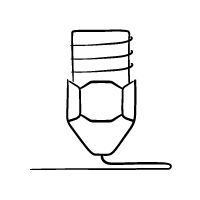PETG / PET
PETG Filament, or Polyethylene terephthalate / glyco, is a popular and user-friendly material for 3D printing. It is today one of the cheapest materials to purchase and known for its properties of being UV and water resistant.
Ease of use
Strength







Extruder
230-250 °C
Metal hotend recommended


Pray
75-90 °C
Does not require any enclosure


Cooling
100%
For the best bearing bond
When is PETG used?
Polyethylene terephthalate (PET) and polyethylene terephthalate glycol (PETG) are leaders in 3D printing with similar polymer structures. PET materials have impressive strength and stiffness, suitable for functional prototypes and final products. Their chemical resistance and resistance to moisture provide usability in various environments. PETG provides increased flexibility and impact resistance with clarity. Both materials have strong layer adhesion and are used in everything from product development to hobby projects.
Both PET and PETG are indispensable in the 3D printing community. PET material stands out with strength, while PETG provides flexibility and impact resistance. Their moisture resistance and affordable nature make them valuable for reliable and affordable projects. Through continued development, PET and PETG shape the 3D printing of the future and strengthen their role in the manufacturing industry.
Advantages
- Cheap
- Water resistant
- Recycling beard
Disadvantages
- Stringing
- Difficult to adjust
- Opaque surface after printing
Tip
Food safe products: PET is known for its ability to meet food safety standards, making it suitable for creating food containers, bottles, and other packaging solutions. Its durability and resistance to chemicals make it a safe choice for preserving and storing food and beverages.
Environmentally Friendly Alternative: By using recycled PET, you contribute to a more sustainable future. Made from renewable sources such as corn and sugarcane, PLA offers biodegradable options for products and packaging, while delivering high-quality results.
Print speed: Use a medium print speed to ensure good accuracy and detail in your print.
Layer Height (Layer Height): Choose an appropriate layer height depending on the project - thinner layers give finer detailed results.
Retraction: Carefully adjust the retraction settings to minimize wire strands and impurities in your PETG print.
Bed Adhesion (Adhesion to the Building Plate): Use kapton tape, glass or special printing surface materials to improve adhesion and minimize the risk of shearing during printing.
Check Humidity: Store the PETG material in a dry and tightly closed container to prevent moisture absorption and reduced print quality. It is especially important to keep PETG material dry as it is more susceptible to moisture than some other types of material.
PET vs. PETG
| Feature | PET | PETG |
|---|---|---|
| Material composition | Polyethylene Terephthalate | Polyethylene Terephthalate Glycol |
| Strength | ● ○ ○ | ● ● ○ |
| Flexibility | Rigid | Moderately Flexible |
| Printability | ● ● ○ | ● ● ● |
| Surface Finish | Smooth | Smooth |
| Layer Adhesion | ● ● ○ | ● ● ● |
| Temperature Resistance | ● ○ ○ | ● ● ● |
| Applications | Transparent Containers, Mechanical Parts | Prototypes, Mechanical Parts, Consumer Products |
*In relation to each other
PLA





ABS





Miscellaneous




